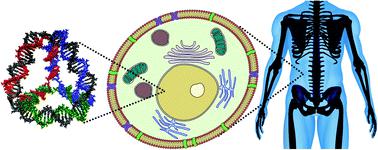当前位置:
X-MOL 学术
›
J. Mater. Chem. B
›
论文详情
Our official English website, www.x-mol.net, welcomes your feedback! (Note: you will need to create a separate account there.)
Understanding the fate of DNA nanostructures inside the cell.
Journal of Materials Chemistry B ( IF 7 ) Pub Date : 2020-04-02 , DOI: 10.1039/d0tb00395f Christopher M Green 1 , Divita Mathur , Igor L Medintz
Journal of Materials Chemistry B ( IF 7 ) Pub Date : 2020-04-02 , DOI: 10.1039/d0tb00395f Christopher M Green 1 , Divita Mathur , Igor L Medintz
Affiliation

|
Structural DNA nanotechnology is poised to transform targeted therapeutic and theranostic delivery agents. Some of the most promising biomedical applications of DNA nanostructures include carriers for biosensing, imaging, and drug delivery. Additionally, the unique ability to precisely position inorganic and organic molecules on DNA-based substrates enables the spatially optimized high density interfacing of ligands with cell membrane receptors. To realize clinically viable biomedical products made from DNA nanostructures, it is necessary to fully understand the behavior of these systems inside and outside the cellular environment. To that end, cohesive and conclusive information on the physiological fate of DNA nanostructures at various time points – from the cell culture to the cell cytosol – is still lacking. In this highlight, we bring to attention efforts to understand DNA nanostructure behavior in vitro as well as some widespread disparities among studies on the subject. We also call for a discussion on the implementation of common standards and controls to address these disparities and consequently unify the scientific community's endeavours to build foundational knowledge on DNA nanostructure–cellular interaction.
中文翻译:

了解细胞内部DNA纳米结构的命运。
结构性DNA纳米技术已准备就绪,可以转化靶向治疗剂和治疗治疗剂。DNA纳米结构的一些最有前途的生物医学应用包括用于生物传感,成像和药物递送的载体。此外,将无机和有机分子精确定位在基于DNA的底物上的独特能力使配体与细胞膜受体在空间上进行了优化的高密度接口。为了实现由DNA纳米结构制成的临床上可行的生物医学产品,有必要充分了解这些系统在细胞环境内外的行为。为此,仍然缺乏有关DNA纳米结构在各个时间点(从细胞培养到细胞质溶胶)的生理命运的内聚性和结论性信息。在这一亮点中,体外研究以及该主题研究之间的一些普遍差异。我们还呼吁就共同标准和控制措施的实施进行讨论,以解决这些差异,从而统一科学界为建立DNA纳米结构与细胞相互作用的基础知识所做的努力。
更新日期:2020-04-02
中文翻译:

了解细胞内部DNA纳米结构的命运。
结构性DNA纳米技术已准备就绪,可以转化靶向治疗剂和治疗治疗剂。DNA纳米结构的一些最有前途的生物医学应用包括用于生物传感,成像和药物递送的载体。此外,将无机和有机分子精确定位在基于DNA的底物上的独特能力使配体与细胞膜受体在空间上进行了优化的高密度接口。为了实现由DNA纳米结构制成的临床上可行的生物医学产品,有必要充分了解这些系统在细胞环境内外的行为。为此,仍然缺乏有关DNA纳米结构在各个时间点(从细胞培养到细胞质溶胶)的生理命运的内聚性和结论性信息。在这一亮点中,体外研究以及该主题研究之间的一些普遍差异。我们还呼吁就共同标准和控制措施的实施进行讨论,以解决这些差异,从而统一科学界为建立DNA纳米结构与细胞相互作用的基础知识所做的努力。


























 京公网安备 11010802027423号
京公网安备 11010802027423号